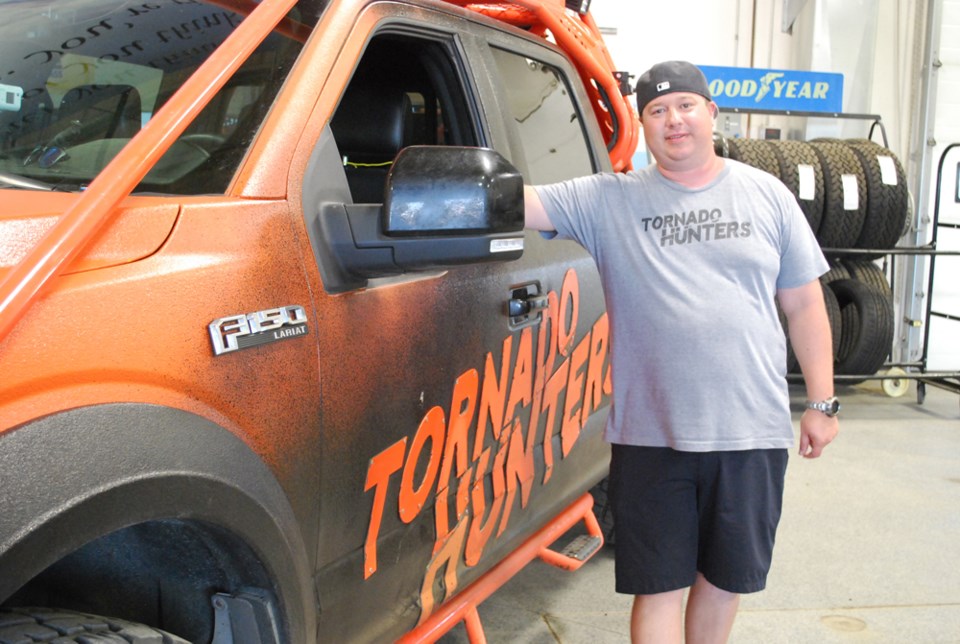Some people call him crazy.
Even his mother says it is time for him to get a real job.
But Tornado Hunter, Chris Chittick, says he would not want to do anything else.
Chittick has been in Humboldt a couple of times the past few weeks, including hanging out in Water Ridge Park for Canada Day.
On Jul. 15, Chittick hung out with Calico Gymnastics at the Discovery Ford barbecue and later gave a presentation at Discovery Ford featuring videos of tornados that him and teammates, Greg Johnson and Ricky Forbes, have chased for the last three years for CMT’s Tornado Hunters.
Chittick started chasing tornados in 1998 and starting his own storm chasing company after graduating with a business degree in 2004.
In 2008, he was approached by Discovery Channel to be a part of the Storm Chaser team and was inside 14 tornados in the five years he was on the show.
“In the name of science we’d purposefully try to get on the inside of tornados to measure temperature, barometric pressure, and wind speed.”
It is not as fun as it sounds, says Chittick and now he much prefers chasing tornados at a close but safe distance.
He has been doing that ever since Johnson contacted him after his departure from Storm Chasers and selling his business, travelling around the world, especially North and South America, chasing storm cells and getting amazing video as the team’s videographer.
Since the start of his career, Chittick has seen 435 tornadoes and 12 major hurricanes.
In March, Chittick and his team are chasing storms in the United States around Texas and Oklahoma. Later in the season, as the jet stream moves north, they see more storms in the American midwest and Canada.
With the data that is available, Chittick says they can predict where a storm is going to be four to five days in advance.
When North America’s largest tornado hit southern Manitoba last July, Chittick says the team drove all day and all night from the southern states in time to chase it after they saw it develop on their radar.
During the North American winter, Chittick says he goes down to South America to chase storms in Argentina where there is no speed limit and tornadoes rotate in the opposite direction.
Tornado seasons go through their own boom and bust cycles with El Niño and La Niña sea temperature fluctuations.
Over his last almost 20 years of storms, Chittick says that the capabilities of sharing storm videos has increased.
“I think now that everyone has their phones and social media, people are just taking pictures and posting them up and that’s bringing to light that there are a lot of tornadoes in Canada.”
Along with talking about chasing tornadoes, Chittick also talked about tornado safety.
There are three types of tornadoes. A wedge which is the widest tornadoes being about 2 miles wide at the base and along the length. This is also the most dangerous one since it takes longer for it to pass you compared to the other two. Another one is a stovepipe, or a cone, which has the narrow base at the ground and it is wide at the clouds. The last one Chittick talked about is the needle tornado which is skinny all the way along.
Even though it looks “wimpy,” says Chittick, the needle actually has the most speed.
When it comes to staying safe during a tornado, seek shelter and turn on a radio or television so you can receive updates. Pay attention to warnings, urged Chittick.
To chase these tornadoes, the team uses high resolution GPS programs and always have a data connection while they are hunting.
Another member of the team is Flash, their 2015 Ford F150 which Chittick brought with him to Humboldt.
Through an adventure in Texas, Chittick says they also know the truck is bulletproof which is great when you are dealing with flying debris.
Another important feature of Flash is the off road capabilities which allows them to get out of any “oops” situation by accessing ditches and fields.
In case it is needed, Flash is also equipped with a cage if an “oops” situation causes them to roll.
According to their website, Flash carries 18 on-board cameras, has travelled 360,000 kilometres through 29 states and has intercepted 51 tornadoes.
Besides recording video and getting pictures of the storms, Chittick says his team also reports to 911 about storm activity so they can send out warnings to the public and the team is also disaster response trained. If a storm hits a populated area they will drop the chase to go in and help.
“We go into search and rescue mode. We’ll go house to house and make sure everyone’s okay.”
Even with the danger involved, Chittick says his tornado hunting has turned from a hobby to a business to a passion.
“I love being on the road and getting close to something dangerous and capturing it, seeing it with my own eyes and then sharing it with the world.”




